
Travel Guide
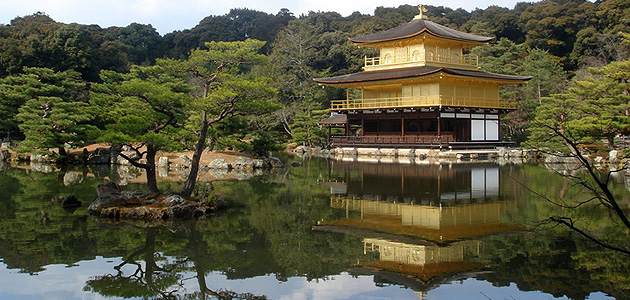
Introduction
Kinkakuji Temple, also known as the Temple of the Golden Pavilion, formally named Rokuonji Temple (Deer Garden Temple), is a Zen Buddhist temple which belongs to the Shokokuji Temple (相国寺) branch of the Rinzai sect of Zen Buddhism.
The beautiful garden is a strolling garden (kaiyu-shiki-teien. A landscape garden in the go-round style) and is an excellent example of Muromachi period garden design. The Muromachi period is considered to be a classical age of Japanese garden design. The correlation between buildings and its settings were greatly emphasized during this period. It was a way to integrate the structure within the landscape in an artistic way. The garden designs were characterized by a reduction in scale, a more central purpose, and a distinct setting. A minimalistic approach was brought to the garden design, by recreating larger landscapes in a smaller scale around a structure.
Kinkakuji Temple is designated as a National Special Historic Site and a National Special Landscape, and it is one of 17 locations comprising the Historic Monuments of Ancient Kyoto World Heritage Site. It is also one of the most popular buildings in Japan, attracting a large number of visitors annually.
History
The site of Kinkakuji Temple was originally a villa called Kitayama-dai, belonging to a powerful statesman, Saionji Kintsune. Kinkakuji Temple's history dates to 1397, when the villa was purchased from the Saionji family by Shogun Ashikaga Yoshimitsu, and transformed into the Kinkakuji Temple complex. Yoshimitsu renounced the throne in the year 1394 and built the villa to spend his the remaining days in quiet seclusion. Yoshimitsu intended to cover the exterior of Golden Pavilion which is the main building of Kinkauji Temple with gold, but only managed to coat the ceiling of the third floor with gold leaf before his death. When Yoshimitsu died, the building was converted into a Zen temple of the Rinzai sect by his son according to his wishes, after his death in 1408.
The Kinkakuji Temple suffered severe damage during the Onin War (1467-77), but was largely restored by virtue of the ninth Muromachi shogun, Ashikaga Yoshihisa (1465-1489). Only two of the original buildings, the Golden Pavilion and the Fudodo (Fudo Hall) survived the firestorm that reduced the temple to ashes in 1565. On July 2, 1950, the pavilion was burned down by a 22-year-old novice monk, Hayashi Yoken, who then attempted suicide on the Daimonji Temple hill behind the building. He survived, and was subsequently taken into custody. The monk was sentenced to seven years in prison, but was released because of mental illnesses (persecution complex and schizophrenia) on September 29, 1955; he died of tuberculosis shortly after in 1956. During the fire, the original statue of Ashikaga Yoshimitsu was lost to the flames (now restored). The writer Yukio Mishima fictionalised these events in his celebrated novel Kinkakuji Temple (1956, The Temple of the Golden Pavilion, translated 1959). An exact reproduction of the original Kinkakuji Temple building was completed in October 1955.
What to see
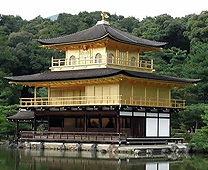 |
Shari-den (Silver Pavilion) Golden Pavilion was formally called Shari-den. It situated picturesquely in the garden at the edge of a lake. This layout is typical of the Shinden style of the Heian period and is intended to suggest a position between heaven and earth. The pavilion extends partially over the pond and is beautifully reflected in the calm waters. The pond contains 10 smaller islands. The zen typology is seen through the rock composition, the bridges, and plants are arranged in a specific way to represent famous places in Chinese and Japanese literature. The four stones forming a horizontal line are called Yodomari-ishi that represent sailboats anchored at night. These boats are bound for the Isle of Eternal Life in Chinese mythology. The pavilion is one of the most beautiful sights in Kyoto. The elegant, beautiful and harmonious building consists of three types of architecture. The 1st floor is Shinden-zukuri, the palace style. It is named Ho-sui-in. The 2nd floor is Buke-zukuri, the style of the samurai house and is called Cho-on-do. The 3rd floor is Karayo style or Zen temple style. It is called Kukkyo-cho. Both the 2nd and 3rd floors are covered entirely (both inside and outside) by approximately 105 pounds of gold leaf. The roof, upon which the Chinese phoenix settles, is thatched with shingles. |
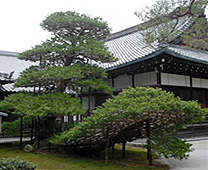 |
Rikusho-no-Matsu Rikusho-no-Matsu is a 600 years old pine tree which is tailored to the shape of a sailing boat. The pine tree was ported from bonsai by Yoshimitsu. It is facing the west, meaning people could ride the boat to the western pure land. |
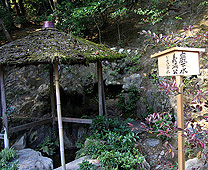 |
Yoshimitsu-en-no-Izumi During the Muromachi period, high ranking Samurai enjoyed their lives with four treasures, tea set and paintings. It is said that Yoshimitsu used the water poured out from here in the tea ceremony. The pond dries up now. |
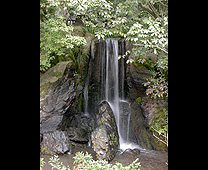 |
Ryumon Waterfall There is a small waterfall at north of Kinkakuji Temple. In the middle is a stone called Rigyo-seki that literally means a carp stone. The story comes from a Chinese legend. In the old days, no fish other than a carp could swim up a waterfall, and by doing so the carp became a dragon. In other words, although it is difficult to overcome some great trouble or challenge, if you do overcome it, you will be successful in life. The stone symbolizes a carp which is struggling to swim upstream. |
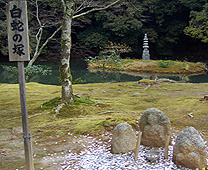 |
Anmintaku Pond and Hakuja-no-Tsuka A little further on from the mirror pond is another small pond, Anmintaku, which contains a stone pagoda called Hakuja-no-Tsuka (the mound in memory of the white snake). Yoshimitsu had many mistresses, and it is said that one of them was deeply jealous of the others and threw herself into the pond, becoming a white snake. So Yoshimitsu built the White Snake Mound to console her soul. That is why some people say that a white snake is the symbol of jealousy. But actually, it was built because the legendary creature was the guardian deity of the Hosokawa family, who had owned this area before. |
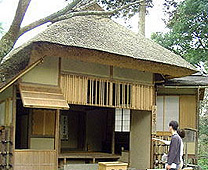 |
Sekka-tei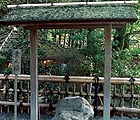 The classic tea house is called Sekka-tei. The tea house is made according to the local Japanese style and is known for a beautiful pillar made from a nandin. The house was restored in 1997. On the way to the exit of the temple, you will find the small Fudodo shrine where the stone Fudo-myoo (Acara), one of the Five Wisdom Kings and protector of Buddhism, is enshrined as a guardian. The statue is said to be carved by Kobo Daishi, one of the most important figures in Japanese religious history. The classic tea house is called Sekka-tei. The tea house is made according to the local Japanese style and is known for a beautiful pillar made from a nandin. The house was restored in 1997. On the way to the exit of the temple, you will find the small Fudodo shrine where the stone Fudo-myoo (Acara), one of the Five Wisdom Kings and protector of Buddhism, is enshrined as a guardian. The statue is said to be carved by Kobo Daishi, one of the most important figures in Japanese religious history. |
Travel Advice
Sightseeing
- Visitors can see Kinkakuji Temple through the live camera on the Japanese official website of Kinkakuji Temple. Kinkakuji Temple covered with white snow can be seen if lucky. The live image will be renewed every 3 minutes.
- The most beautiful view in Kinkakuji Temple is the Golden Pavilion reflects in the calm waters.
- It is recommended to visit Kinkakuji Temple before 10 am. The Golden Pavilion looks gorgeous and brilliant when the sun shines on the gold leaf.
- The ticket is very unique, it looks like a talisman, that wishing your family safe, good fortune and prosperity.
- Kitayama culture is often contrasted with Higashiyama culture. Kinkakuji Temple was built to echo the extravagant Kitayama culture that developed in the wealthy aristocratic circles of Kyoto during Yoshimitsu's times. On the other hand, Ginkakuji Temple is one of the constructions that represent the Higashiyama culture of Muromachi period. Visitors visit both temples at the same time could understand the difference between the two cultures and the history.
Visit
| Address | 1 Kinkakuji Temple-cho, Kita-ku, Kyoto-shi, Kyoto | |
| Phone | 075-461-0013 | |
| Admission | Adult: 400 yen Student: 300 yen |
Adult: over 15 Student: 6 to 14 |
| Hours | 09:00 to 17:00 | Entry until 30 minntes before closing |
| Closed | Open 7 Days a Week | |
| Duration | 30 minutes | |
| Getting There | By Train 30 minutes ride by City Bus No.101 or 205 bound for Kyoto from JR Kyoto Station to the Kinkakuji Temple-michi bus stop, then walk approximately 5 minutes. By Car Take Meishin Expressway to Kyoto-mimani exit and take National Highway route 1. It is approximately 40 minutes from exit. |
|
| Parking | Paid parking available | |

